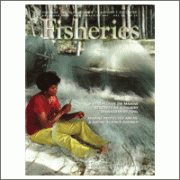Worldwide Decline of Eel Resources Necessitates Immediate Action: Quebec Declaration of Concern
AUTHOR(S): John M. Casselman and David K. Cairns
CITATION:
Casselman, J.M. and D.K. Cairns. 2003. Worldwide decline of eel resources necessitates immediate action: Québec declaration of concern. Fisheries 28:(12) 28-30.
SUMMARY:
The International Eel Symposium 2003 at the Québec City AFS Annual Meeting, convened by Casselman and Cairns, focused on worldwide concern about the declining status of anguillid eels, their assessment and management. The symposium resulted in a universal call to action. Since the symposium, the concern is now being widely publicized. The declaration stemming from the symposium is provided here.
Worldwide decline of eel resources necessitates immediate action: Québec Declaration of Concern
The steep decline in populations of eels (Anguilla spp.) endangers the immediate future of these legendary fish. With less than 1% of major juvenile resources remaining, precautionary action must be taken immediately to sustain the stocks.
Eels are curious animals. Despite decades of scientific research, crucial aspects of their biology remain a mystery. In recent decades, juvenile abundance has declined dramatically (Figure.1): by 99% for the European Eel (A. anguilla) and by 80% for the Japanese Eel (A. japonica). Recruitment of American Eel (A. rostrata) to Lake Ontario, near the species’ northern limit, has virtually ceased. Other eel species also show indications of decline. The causes of the downward trends are yet unclear, in part due to the catadromous life history of these fishes, which has so far made it impossible to observe their spawning adults in the open ocean. Because of this, the annual spawning stocks of eels that successfully complete the long migration to their spawning areas have never been assessed. The lack of access to basic life history information about the oceanic phase of eels makes it especially difficult to monitor and identify the cause of their population declines. This is in distinct contrast with other declining fishes such as anadromous salmon, whose spawning adults can be relatively easily surveyed when they return to freshwater to spawn, and Atlantic Cod, which spawn relatively close to continental margins and can be surveyed by standard fishery techniques. In the case of eels, which depend on freshwater and estuarine habitats for their juvenile growth phase, anthropogenic impacts (e.g., pollution, habitat loss and migration barriers, fisheries) are considerable and may well have been instrumental in prompting these declines. Loss of eel resources will represent a loss of biodiversity but will also have considerable impact on socioeconomics of rural areas, where eel fishing still constitutes a cultural tradition. Research is underway to develop a comprehensive and effective restoration plan. This, however, will require time. The urgent concern is that the rate of decline necessitates swifter protective measures. As scientists in eel biology from 18 countries assembled at the International Eel Symposium 2003 organized in conjunction with the 2003 American Fisheries Society Annual Meeting in Québec, Canada, we unanimously agree that we must raise an urgent alarm now. With less than 1% of juvenile resources remaining for major populations, time is running out. Precautionary action (e.g., curtailing exploitation, safeguarding migration routes and wetlands, improving access to lost habitats) can and must be taken immediately by all parties involved and, if necessary, independently of each other. Otherwise, opportunities to protect these species and study their biology and the cause of their decline will fade along with the stocks.
FULL TEXT – Casselman and Cairns



